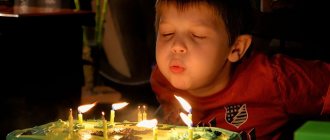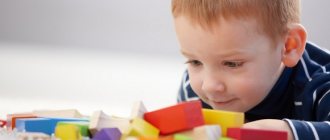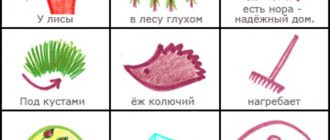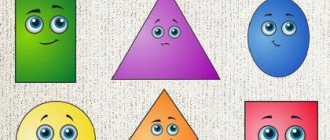One of the important features of a child in the future is the development of thinking today. It is important to start paying attention to this as early as possible.
There is such a thing as a “sensitive period”. This is the optimal stage for developing a particular skill. For children, the period when the foundation is laid is from 1 year to 7 years.
In the article we will talk about the stages of development of thinking in children, methods, and the connection of thinking with other skills.
Features of thinking in preschool age
The brain of a preschooler is mobile and malleable, open to new knowledge. That is why useful habits, the desire to engage in sports, music, theater and art are laid precisely in the preschool period.
In order for a child to analyze and think, it is necessary to constantly set new tasks for him, as well as modernize and complicate the skills he has already acquired.
There are several factors that have a strong influence on a child’s thinking:
- Circle of friends. The older the child, the more children and adults there should be around him. Kindergartens, clubs and sections help with this. The child must observe different behavior patterns of both adults and children.
- Speech development. The child learns to construct sentences and express his thoughts.
- Formation of an analytical worldview. Preschool children are characterized by paying attention to shapes, color, size, spatial arrangement and time frames.
- Acquiring skills and abilities. The child learns to retell, read syllables, and sing.
- Formation of personal qualities. Character, adaptability, initiative, organization - all this is formed as a result of educational activities.
- Formation of self-esteem. A developed child is able to evaluate himself.
- The emergence of self-control. The child learns to manage his behavior and actions.
How to develop preschool children - said Maya Makieva, child psychotherapist
Preschool children actively explore the world and therefore have great curiosity about everything that happens around them. They greedily absorb all the information that adults offer them, as they dream of growing up quickly, becoming smart and strong. Therefore, it is simply impossible to overestimate the role of parents in shaping the child’s thinking.
Games are of great importance in a child's life. It is during play that the most rapid and high-quality development of the child’s imagination occurs, the active work of all thought processes and the assimilation of new information, since the child wants to learn and do something new through play. It is through the game that parents have the opportunity to convey important information to the child, form the values and rules of life for their child, since in the game the child is ready to listen and hear you.
This article presents excellent options for short-term games that will allow you to develop all types of thinking, diversify your communication with your child, as well as spend time with him with benefit and interest. But remember that these games must be strictly dosed, and if you see that the child is starting to get tired, end the game on time.
Stages of development of thinking
- visually effective;
- visual-figurative;
- verbal-logical.
Visual and effective thinking is formed at the age of 1-3 years. When, as a result of his actions, a child, without realizing it, draws conclusions “for the future.” And proof of this are toys, keyboards, and parental gadgets disassembled for spare parts. The purpose of these actions is to know “what’s inside?”
At the age of 3-7 years, visual-figurative thinking is formed. It is during this period that the first signs of analysis appear. For example, having certain skills, a child can already tell what a toy will feel like when he sees it in a store window. Many can already predict the situation.
Closer to 6 years, the first inclinations of verbal and logical thinking appear. At this stage, the child begins to give detailed answers after analyzing information, is able to arrange the sequence of events in the correct order, and can characterize almost any object. Speech is of paramount importance on the development of a child’s thinking.
On the topic: methodological developments, presentations and notes
Gender differences in the thinking characteristics of preschool children
In connection with the changes taking place in the preschool education system, the most pressing issue has become the gender approach to the education of preschool children...
Features of the development of logical thinking of preschool children with the help of logical and mathematical games
It is most advisable to develop the logical thinking of an older preschooler in line with mathematical development.
The development of logical thinking through didactic logical-mathematical games is important... Features of the development of thinking in preschool children.
Are we brothers in mind? There is still an opinion in families that a child is a small, imperfect adult who knows less and understands life less well, that the differences between a child and an adult are purely quantitative...
Features of the thinking of preschool children
Features of the thinking of preschool children...
Seminar for teachers “Features of the development of logical thinking in preschool children”
Development of logical thinking, functions of logical games. Practical advice for teachers….
Report on creating conditions for the formation of imagination and imaginative thinking in preschool children through artistic and aesthetic activities.
Report on creating conditions for the development of imaginative thinking and imagination of preschool children.....
Features and stages of development of thinking of preschool children
Thinking is a cognitive process of a higher level compared to the direct sensory reflection of reality in sensations, perceptions, ideas. Sensory knowledge gives only...
- I like
Sources used:
- https://alldoshkol.ru/process/razvitie-myshleniya-u-doshkolnikov
- https://marypop.ru/doshkolnik/razvivayushhie-zanyatiya/razvitie-myshlenija.html
- https://nsportal.ru/detskii-sad/vospitatelnaya-rabota/2017/07/04/osobennosti-vidy-i-svoystva-myshleniya-detey
Mental operations
Observing how a child’s thinking develops, the entire thought process can be divided into stages:
- comparison;
- analysis;
- synthesis;
- generalization.
At the comparison stage, the child learns to find the same in different things, different in the same. During this period, it is appropriate to give “find the differences” pictures and play memory games (start with 6 pairs of pictures, gradually increasing the number).
At the analysis stage, features, qualities, properties, materials and objects used are identified. In his imagination, a child can divide any product into its component parts.
The synthesis stage is closely related to the analysis stage. Without analysis it will not be possible to synthesize. An example of this is reading. Without remembering letters, without understanding how they merge into syllables, a child will not be able to read.
Vivid signs of generalization are the identification of common characteristics of objects and grouping. As soon as a child develops coherent speech and the use of a large number of generalizing concepts, you know that the generalization stage has begun.
Thinking and its role
You can understand how quickly and correctly a child’s thinking develops through certain operations.
Comparison
It can be performed by children starting from 2 years old, comparing objects according to their characteristics, seeing the difference or similarity between them.
Generalization
Such activity develops closer to 6-7 years. For example, you can ask the child to name several objects (cup, spoon, pan), in one word - “dishes”. Young children are unlikely to understand what is wanted from them.
Analysis
Children begin to analyze at the age of 3-4 years. For example, a child can conduct an analysis: what paper, wood, etc. is made of. This way you can understand that he has begun to master its technique.
Synthesis
This operation can be contrasted with analysis. A striking example of this is the development of reading skills by a preschooler. First, he studies sounds and letters, then learns to put them into syllables, words, sentences and text.
Classification
By carrying out this operation, the child learns to identify similarities or differences between the objects and phenomena around him. And after identifying common features, it classifies objects into one group, for example, dividing toys into groups made from the same material.
Interesting: Simple experiments for children at home
How to develop a preschooler's thinking
The development of thinking occurs through play, as this is the leading type of activity. You can beat everything. From a pedagogical point of view, it should be developed in different directions. Involve your child more in housework.
Check out the table; it contains the main types of exercises for developing thinking in children, which we focus on in our classes.
| Types of activities | Description |
| Memory development task | Memorizing image elements, sequence of details, etc. |
| Logic exercises | Find what is missing, identify a pattern using analysis, comparison, reasoning |
| Classification tasks | Sorting, grouping by characteristics, etc. |
| Exercises for concentration | Finding identical properties, differences between objects, images, etc. |
| Tasks for the development of spatial perception | Development of visualization, spatial arrangement, solving puzzles and puzzles |
| Exercise to develop analytical skills | Search for details that are superfluous or not true |
| Tasks for the formation of a strategic approach | Thinking through a whole chain of actions. Analysis of sequences and results |
What educational games to play with your child - said Ekaterina Patrina, teacher
Some of the games suggested above will require more time and attention from parents, while some other games can be done without any dedicated time. In any case, parents must understand that all this is an invaluable contribution to the child’s life and to his future. For example, the game “Associations” can be played on the way to kindergarten, school, or just while walking.
Among the proposed games, all are important and they all need to be given the same amount of time in order to grow a full-fledged personality. However, based on my experience working with students and adults, I would recommend that parents pay special attention to games that develop critical thinking. If you do not develop it in childhood, it will be even more difficult to develop it in adulthood.
In English classes, I often have to work with people who have a higher education, a prestigious job, a family, and a range of interests. But in almost every lesson they have difficulty answering a question in detail, often making do with short “yes” and “no,” although the topics for discussion can be very simple: movies, travel, work, friends. It is impossible to learn to speak a foreign language without detailed answers, which is why in my classes I often teach students to think critically, although all this can be learned much more easily in childhood.
Exercises and games to develop thinking in preschoolers
Let's look at options for exercises and games that can be easily used in everyday life by the whole family.
Games for the development of visual and effective thinking
- “Sort into groups” is a game in which the work of the eyes and hands is leading. For example, place large spoons, dessert spoons and tea spoons in front of your child. Ask them to sort them. The child must decide for himself on what principle to do this.
- Game "Build a Row". Cylinder blocks, color plates, heat bottles, flavor bottles, tangram and other materials can be used here. For example, you need to build a row from large to small. Cylinder blocks from the Montessori method are used. Colored plates of the same color, but different shades, must be arranged from darkest to lightest.
- Game "Find a place for the nesting doll." It will require nesting dolls (at least 6 pieces). We arrange the figures in a row at an equal distance from each other. Then we ask the child to close his eyes, remove one figure, and align the rest. The baby opens his eyes and tries to find the place between which figures the matryoshka stood. As the task is completed, the number of components should increase.
Games for the development of visual-figurative thinking
- Game "What does it look like?" There are a lot of variations of it. One of them might be to show an image of a fancy blob. Give your child the opportunity to think about what it is, who it is, what it tastes like, what it smells like, what it does and other signs.
- Game “Say it in one word.” Depending on the age of the child, the approach to identifying objects will change. For children 3-4 years old - simple generalizations such as: furniture, dishes, berries, flowers. For a child aged 5 years, the generalization should be deeper, for example: insects, wild animals, pets, professions, etc. Children 6-7 years old already operate with such concepts as animals of Africa, Asia, fruits of Europe, Asia, etc.
- Game "Give a definition." The child is offered an object that he characterizes. For example, we show a mug that needs to be described: big, dad’s, fragile, glass, etc. And then the child shows you the object, and you characterize it.
Games for the development of verbal and logical thinking
- Game "Collect the picture." It is analogous to puzzles. The child’s task is to assemble a whole picture from several parts. The older the baby, the more details.
- Game "Continue the Row". Draw a chain and a row of beads in a certain sequence: yellow, green, blue, pink, and then repeat the row once and invite the child to continue. The older the child, the more beads there are, and their sizes change.
- "Opposites". A game of matching the opposite. For example, you say cold, but the child picks up hot; wet-dry; black and white and so on.
- Game "Guess what it's about." You consistently describe the subject, and the child guesses what you are talking about. For example: round, striped, sweet, juicy - watermelon.
Diagnostics of visual-figurative thinking
Cut along the contour
To do the exercise:
1. Print the table;
2. Cut the table into 6 parts;
3. Give your child scissors that are comfortable for him;
4. Take turns giving the child pieces to cut out (they are numbered);
5. The child’s task is to cut as quickly and accurately as possible.
Evaluation of results
10 points - all figures were cut out by the child in no more than 3 minutes, and the contours of the cut out figures differed by no more than 1 mm from the given samples.
8-9 points - all the figures were cut out by the child in a time of 3 to 4 minutes, and their contours differ from the originals by 1 mm to 2 mm.
6-7 points - all the figures are cut out by the child in a time of 4 to 5 minutes, and their contours differ from the originals by 2-3 mm.
4-3 points - all the figures were cut out by the child in a time of 5 to 6 minutes, and their contours differ from the originals by 3-4 mm.
2-3 points - all the figures were cut out by the child in 6 to 7 minutes, and their contours differ from the originals by 4-5 mm.
0-1 point - the child did not complete the task in 7 minutes, and the figures he cut out differ from the originals by more than 5 mm.
Conclusions about the level of development:
10 points - very high 8-9 points - high 4-7 points - average 2-3 points - low 0-1 point - very low
It would seem such a simple task, but there are children who find it difficult to complete it even when they are already in 1st grade. Therefore, pay attention to how your baby knows how to work with scissors.
Go through the maze
In this task, children are shown a labyrinth and explained that it depicts a labyrinth, the entrance to which is indicated by an arrow located at the top left, and the exit is indicated by an arrow located at the top right. You need to do the following: taking a pencil in your hand, moving through the labyrinth, go through it as quickly as possible, without touching the walls of the labyrinth.
Evaluation of results
10 points - the child completed the task in less than 45 seconds. At the same time, the child never touched the walls of the labyrinth with the stick.
8-9 points - the child completed the task in a time from 45 seconds to 60 seconds, and, while passing through the labyrinth, the child touched its walls with a stick 1-2 times.
6-7 points - the child completed the task in a time from 60 seconds to 80 seconds, and while going through the labyrinth, the child touched its walls 3-4 times.
4-5 points - the child completed the task in a time from 80 seconds to 100 seconds, and while going through the maze, the child touched its walls 5-6 times.
2-3 points - the child completed the task in a time from 100 seconds to 120 seconds, and while going through the labyrinth, the child touched its walls 7-9 times.
0-1 point - the task was completed by the child in more than 120 seconds or not completed at all.
Conclusions about the level of development
10 points - very high 8-9 points - high 4-7 points - average 2-3 points - low 0-1 point - very low
This exercise also helps develop reading skills.
Trace the outline
This diagnosis can be carried out 2 times, using different drawings.
The child is shown a drawing and explained that the task is to use a pencil or pen to reproduce as quickly and accurately as possible on the right half of the same drawing the outline that is presented on its left side. You must try to make all lines straight and accurately connect the corners of the figures. It is also desirable that the contours of the figures be reproduced in the same places where they are shown in the drawings - samples on the left side. At the end of the task, accuracy, accuracy and speed of work will be assessed.
Evaluation of results
Grades are given in points depending on the speed and quality (accuracy) of completing the task:
10 points - the child spent less than 90 seconds completing the entire task, and all the lines are straight and accurately connect the corners of the figures. All lines follow exactly the specified contours.
8-9 points - it took from 90 seconds to 105 seconds to complete the task. In this case, at least one of the following shortcomings occurs: one or two lines are not completely straight; in two or three cases the drawn lines do not quite correctly connect the corners of the figures; from two to four lines extend beyond the contour; four to five corners are not connected exactly.
5-7 points - the entire task took from 105 to 120 seconds to complete. At the same time, at least one of the following defects was additionally discovered: three or four lines are indirect; from four to six corners are not quite accurately connected; five to six lines extend beyond the contour; six to seven corners are not quite accurately connected.
4-5 points - it took from 120 seconds to 135 seconds to complete the task. There is at least one of the following defects: five or six lines are not completely straight; from seven to ten corners are not connected quite correctly; there are seven or eight lines that are not quite straight; there are from eight to ten corners that are not quite precisely connected.
2-3 points - it took from 135 to 150 seconds to complete the task. At least one of the following deficiencies is noted; from seven to ten lines are indirect; from eleven to twenty corners are not connected quite correctly; from nine to eighteen lines extend beyond the contour; from eleven to seventeen corners are not connected quite correctly.
0—1 point —it took more than 150 seconds to complete the task. Almost all the lines, with the exception of one or two, are not straight; Almost all the corners, with the exception of one or two, are connected incorrectly.
Conclusions about the level of development:
10 points - very high 8-9 points - high 4-7 points - average 2-3 points - low 0-1 point - very low
If the child performed this task poorly, I recommend doing additional exercises on the ability to compare, as well as training the child’s attention.








